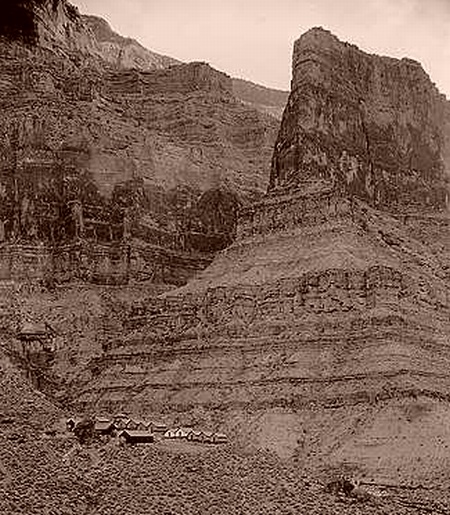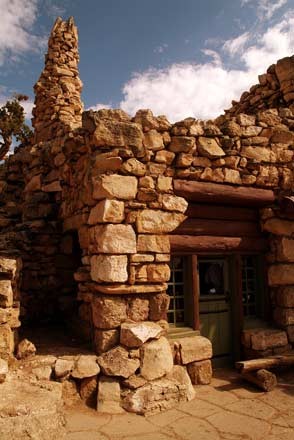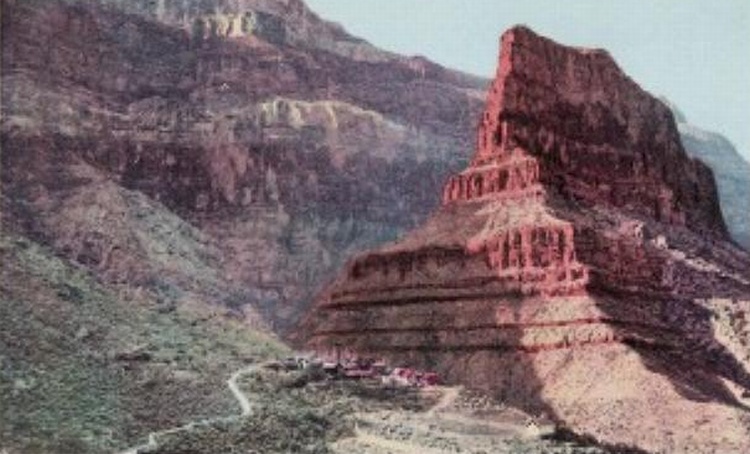Historic Significance
Following construction of El Tovar in 1905, the Atchison, Topeka & Santa Fe Railroad was given the task of "developing" concessions for Grand Canyon in 1911. Part of that task was to create an alternative to Ralph Cameron's Bright Angel Toll Trail. The Railroad contracted with the Harvey Co. to improve the Hermit Trail at the western end of the rim road, and to build a luxury camp for well-to-do patrons.
The plan was to provide mule trips to the river and back, competing directly with Cameron's Bright Angel operation. By 1911 the old Bright Angel Hotel and tourist camp was a bit run down and generally crowded, but the mule trip was a standard attraction for El Tovar guests. The Hermit Camp trip was to be the Harvey Company's superior offering, suitable for patrons of their hotel -- luxury all the way, with the finest meals and the most comfortable "camping" possible.
The trip began with a 9-mile stage ride to the trailhead, where customers mounted mules and began their descent. After stopping for tea and a brief rest at the camp, they continued on mule or on foot on a relatively short trail to the river. Returning to camp in the early evening, guests enjoyed a hearty meal prepared by fine chefs. The scene in the dining room would be much like that at today's Phantom Ranch; guests dined together and engaged in lively conversation.

above, an early photograph of Hermit Camp in its incredible setting.
Lodging, likewise, was much the same as in many of today's national park back-country camps. Accommodations in Yosemite's High Sierra Camps, for example, are virtually identical today to those in Hermit Camp circa 1912. Cabins had pine flooring, wooden sides, and canvas roofs. Foundations were leveled on rock pilings. Interiors had extremely comfortable beds with fresh linens, an Indian style rug, chairs, and a small wood stove for chilly evenings. According to the Harvey Company's promotional brochures, "it is camping out de luxe." And just like today's concessioners, they promised an "unforgetable evening under the stars."
After a restful night, campers awoke to a massive breakfast, also prepared by the Harvey Co. chefs. A few guests might take a short stroll prior to departure, and then they'd return via mule to the rim. A stage then returned guests to the El Tovar.
The cost for this entire outing was recorded in 1927 as $18.25 per person. This translates to $216 today, which is a bit less than the current $272. charged for a mule trip and overnight stay at Phantom Ranch. Considering that Hermit Camp was stocked each day by a cable car, while Phantom Ranch relies strictly on more costly mule service, the difference is understandable.
Thanks to the Santa Fe Railroad's promotional efforts, mule trips became more or less synonymous with a visit to the Grand Canyon. Hermit Camp expanded at one point during its brief tenure, but the specifics are unknown and not particularly important. The truly significant expansion of Hermit Camp happened miles away at the rim, not at the Camp.
After construction of Hermit Camp it became immediately apparent that some sort of comfort facilities were needed between the long carriage ride and the mule trip. The rim trip was also becoming increasingly popular with El Tovar guests who elected not to take the mule ride, but simply to enjoy a scenic outing. The trailhead was spartan to say the least; the mules relaxed in their corrals, but paying customers had no such facilities.
Staff architect Mary Jane Colter was tasked with developing a suitable comfort station at the trailhead. The result was Hermit's Rest, completed in 1914.

Hermit's Rest, photo courtesy Xanterra Corp.
Like her other Canyon buildings, Colter drew her inspiration from the immediate locale. And like the others, Hermit's Rest is an imaginative outgrowth of that inspiration, with no real resemblance to any historical structure. Colter's muse was Louis Boucher, the legendary "hermit" for which Hermit Gorge is supposedly named. Boucher is said to have spent time holed up in a rock shelter during his mining forays into the canyon. He supposedly fashioned something of a home in the shelter, although evidence points to little more than a fire pit and likely bedding. Colter developed a rim side "rock shelter," imagining what it might've been if a hermit with nothing more than a pile of rocks (and lots of money and laborers) had created it.
The structure features seemingly random piles of rocks tucked into a hillside. The hillside was designed by Colter as well. It evokes the atmosphere of a cave. Naming it Hermit's Rest, Colter had a ready-made back story, and the little comfort station quickly became a tourist destination all on its own fabricated merits. Colter designed in an aged, dilapidated look. She took quite a ribbing for this intentional "dilapidation" in the early years; but with time her artistic vision is now fully appreciated. Fortunately most of the structure is true to the original, as are the interior furnishings.
Although Hermit's Rest is generally touted as an example of parkitecture, it is technically free-form design. The building uses rubble, local stone, masonry, earth, and logs to create a structure so closely tied to the earth that it almost appears to have sprung from the ground on its own.
The young National Park Service gained control of Cameron's Bright Angel Trail in the early 1920s. Colter set to work on Phantom Ranch in 1922, and the Hermit Camp mule trip was soon competing against a newer, more conveniently located Harvey Company enterprise. Patronage dropped off at Hermit Camp, and a fire in the dining hall sealed the facility's fate in 1930 [facts not confirmed; NPLAS to verify sequence/timing]. The remaining structure fell into disrepair as the Harvey Company abandoned Hermit Camp. Materials were dismantled and stolen during the next few years, until the Park Service ordered that the Harvey Company was to salvage what they could and demolish and burn the rest [circa 1936].
Today the Hermit Camp is a historical curiosity for hikers en route to Hermit Campground, located a bit further down the trail. A few stone foundations remain clearly visible, and other artifacts can be found with a bit of searching. Fortunately the real jewel of the Hermit Camp operation, Hermit's Rest, is open to visitors and will be preserved indefinitely.

